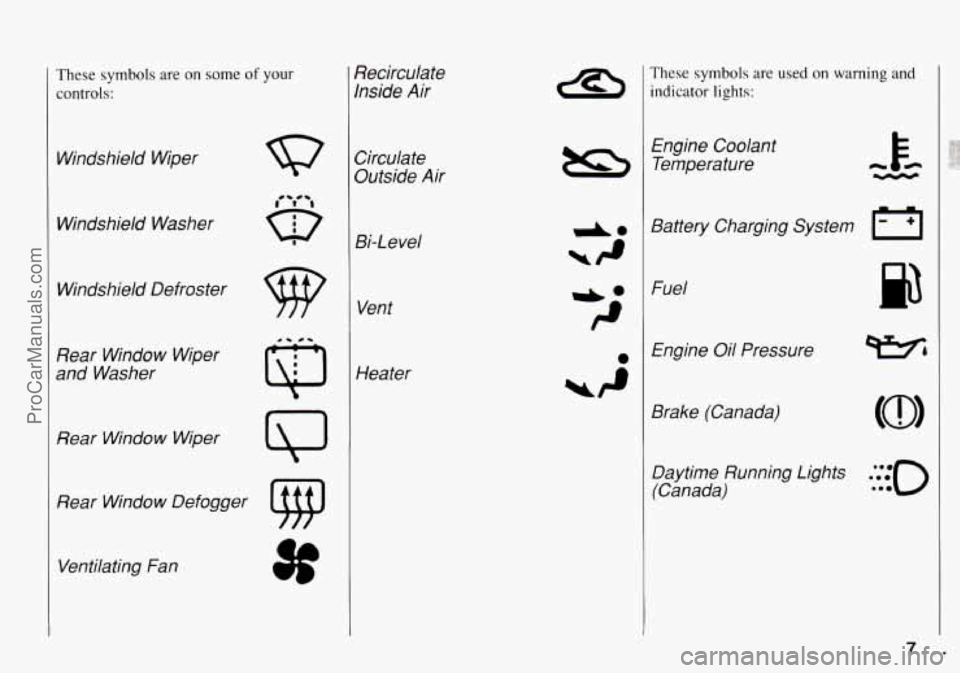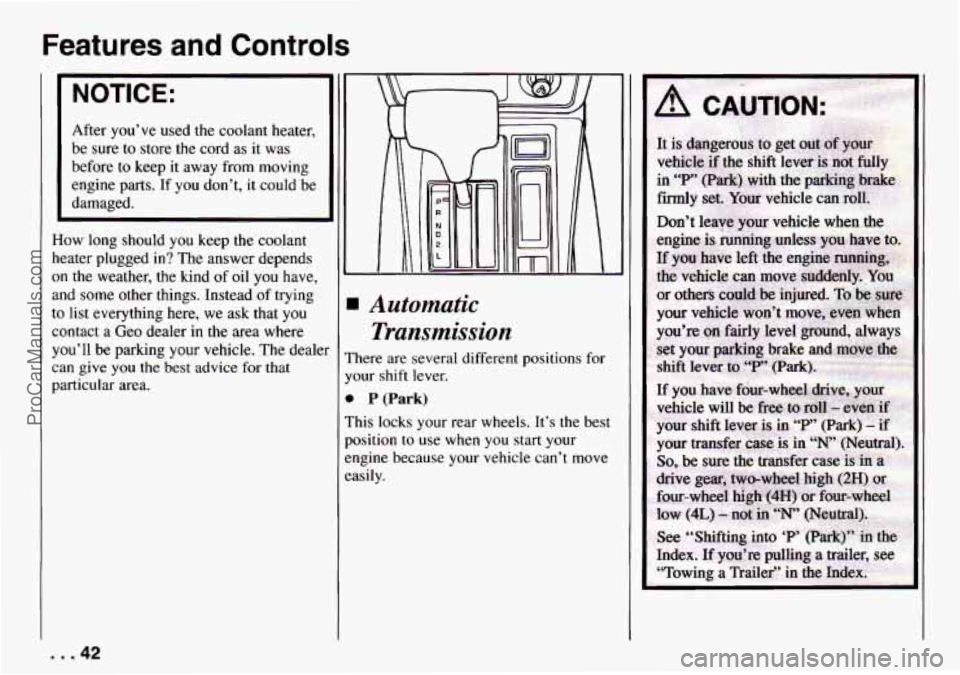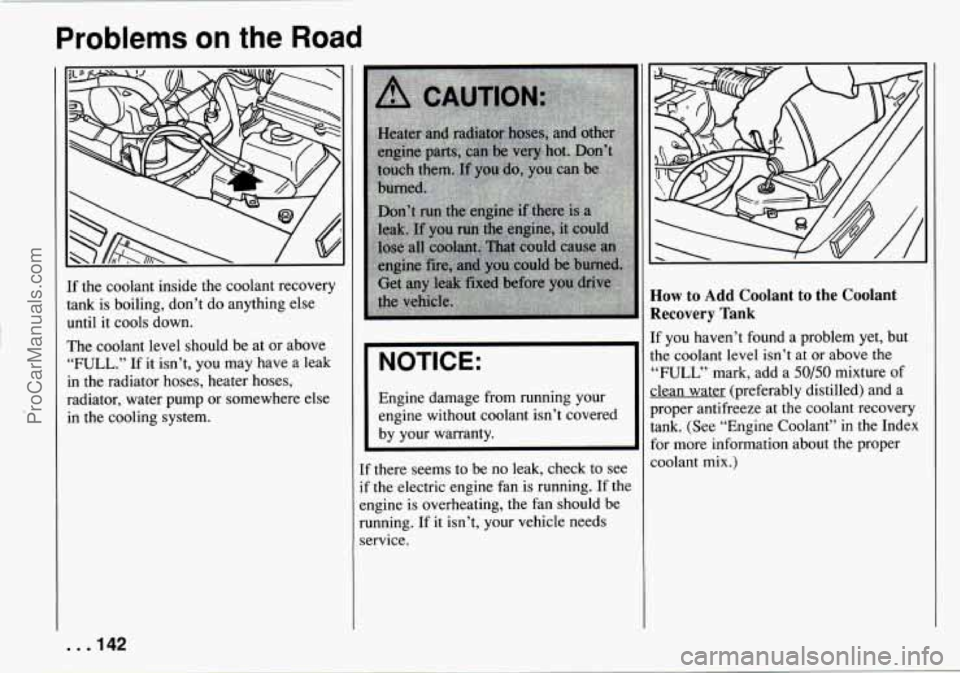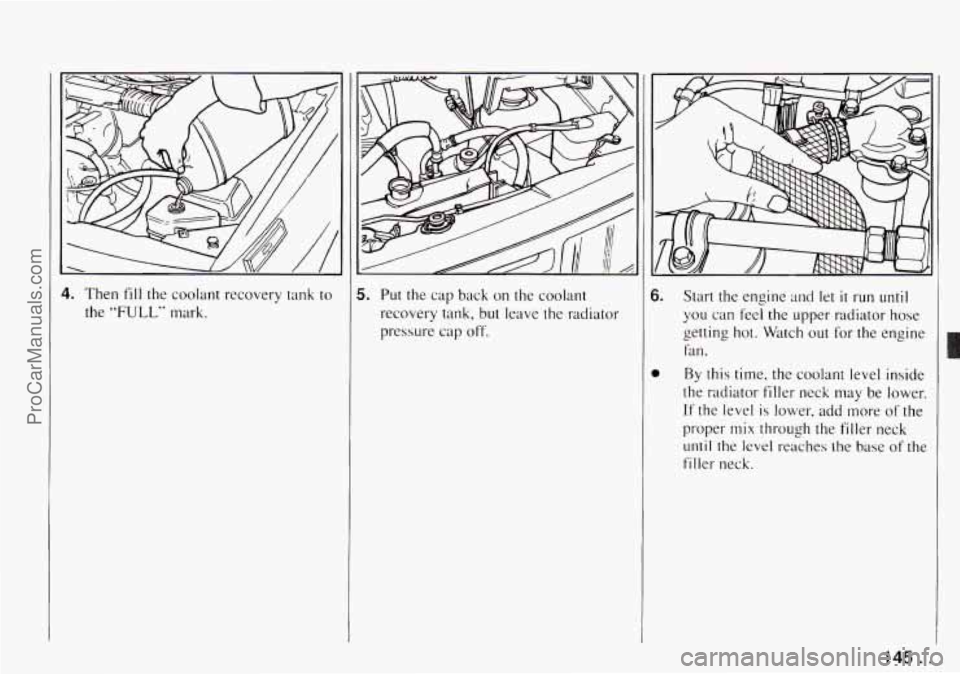engine coolant CHEVROLET TRACKER 1994 Owners Manual
[x] Cancel search | Manufacturer: CHEVROLET, Model Year: 1994, Model line: TRACKER, Model: CHEVROLET TRACKER 1994Pages: 258, PDF Size: 14.43 MB
Page 8 of 258

These symbols are on some of your
controls:
Windshield Wiper
Windshield Washer
Windshield Defroster
Rear Window Wiper
and Washer
Rear Window Wiper
Rear Window Defogger Ventilating Fan Recirculate
Inside
Air
Circulate
Outside Air
Bi-Level
Vent
Heater
These symbols are used on warning and
indicator
lights:
Engine Coolant Temperature
Battery Charging System
Fl
Fuel
Engine Oil Pressure
Brake (Canada) Daytime Running Lights
.***to
(Canada) **e
f ...
ProCarManuals.com
Page 42 of 258

NOTICE:
Holding your key in “START” for
longer than 15 seconds at a time will
cause your battery to be drained
much sooner. And the excessive heat
can damage your starter motor.
2. If it doesn’t start right away, hold
your key
in “ START” for about three
seconds at a time until your engine
starts. Wait about 15 seconds between
each
try to help avoid draining your
battery.
If your engine still won’t start, call your
dealer for help.
NOTICE:
Your engine is designed to work with
the electronics in your vehicle. If you
add electrical parts or accessories,
you could change the way
the fuel
injection system operates. Before
adding electrical equipment, check
with your dealer. If you don’t, your
engine might not perform properly.
If you ever have to have your vehicle
towed, see the part of this manual
that tells how to do
it without damag-
ing your vehicle. See “Towing Your
Vehicle” in the Index.
)riving through Deep Standing
Water Engine Coolant Heater (Engine
Block Heatel‘) (CANADA)
In very
cold weather, 0 OF (- 1 8 O C) or
colder, the engine coolant heater can help.
You’ll get easier starting and better fuel
economy during engine warm-up.
Usually, the coolant heater should be
plugged in a minimum
of four hours
prior to starting your vehicle.
To use the coolant heater:
1. Turn off the engine.
2. Open the hood and unwrap the
electrical cord.
3. Plug it into a normal, grounded
110-volt outlet.
NOTICE:
If you drive too quickly through deep
puddles
or standing water, water can
come in through your engine’s air
intake and badly damage your
engine.
If you can’t avoid deep
puddles or standing water, drive
through them very slowly.
41 ..
ProCarManuals.com
Page 43 of 258

Features and Controls
NOTICE:
After you’ve used the coolant heater,
be sure to store the cord as
it was
before to keep
it away from moving
engine parts. If you don’t, it could be
damaged.
How long should you keep the coolant
heater plugged
in? The answer depends
on the weather, the kind
of oil you have,
and some other things. Instead of trying
to list everything here, we ask that you
contact a Geo dealer in the area where
you’ll be parking your vehicle. The dealer
can give
you the best advice for that
particular area.
Automatic
Transmission
There are several different positions for
your
shift lever.
0 P (Park)
This locks your rear wheels. It’s the best
position to use when you start your
engine because your vehicle can’t move
easily.
1
-..42
ProCarManuals.com
Page 71 of 258

Features and Controls
If the light comes on while you are
driving,
pull off the road and stop
carefully. You may notice that the pedal is
harder
to push. Or, the pedal may go
closer to the floor. It may take longer to
stop. If the light is still on. have the
vehicle towed for service. (See “Towing
Your Vehicle“
in the Index.)
p CAUTION:
Your brake system may not be work-
ing properly if the brake system
warning light is on, Driving with the
brake system warning light on can
lead
to an accident. If the light is still
on after you’ve pulled off the road
and stopped carefully, have the
vehicle towed
for service.
The brake system warning light will also
come
on when you set your parking
brake, and
it will stay on if your parking
brake doesn’t release
fully. If it stays on
after your parking brake is fully released.
it means you have a brake problem.
‘ngine Coolant Temperature Gage
rhis gage shows the engine coolanl
emperature.
If the gage pointer moves to
he
”H” (red) side. your engine is too hot!
t means that your engine coolant has
)verheatcd and you should
stop your
ehicle and
turn off the engine HS soo~
Iossible.
1 as
HOT COOLANT CAN BURN YOU
BADLY!
In “Problems on the Road.” this manual
shows what to do. See ”Engine
Overheating”
in the Index.
Charging System Light
This light will come on briefly when you
turn on the ignition, but the engine is not
running, as
a check to show you it is
working. Then
it should go out when the
engine starts. If it stays on or comes on
while you are driving, you may have a
problem with the electrical charging
system.
It could indicate that you have a
loose generator drive
belt or another
electrical problem. Have
it checked right
away. Driving while this light is on could
drain
your battery.
If you must drive a short distance with
this light on,
be certain to turn off all your
accessories. such as
the radio and air
conditioner.
. . .70
ProCarManuals.com
Page 123 of 258

Your Driving and the Road
0 Know how to go down hills. The mosl
important thing
to know is this: let
your engine do some of the slowing
down. Shift
to a lower gear when you
go down a steep or long hill.
If you don’t shift down, your brakes
could get so hot that they wouldn’t
work well.
You would then have poor
braking
or even none going down a
hill. You could crash. Shift down to
let your engine assist your brakes on
a steep downhill slope.
A CAUTION:
t 0
1
0
0
0
Coasting downhill in “N” (Neutral)
or with the ignition off is dangerous.
Your brakes will have to do all the
work of slowing down. They could
get
so hot that they wouldn’t work
well.
You could crash. Always have
your engine running and your vehicle
in gear when you go downhill. Know how to
go
uphill. You may
want to shift down
to a lower gear.
The lower gears help cool your engine
and transmission. and you can climb the
hill better.
Stay
in yo~~r own lane when driving
on two-lane roads
in hills or
mountains.
Don’t swing wide or cut
~tcross
[he center of the road. Drive at
speeds
that let you stay in your own
lane.
As you go over the top of a hill. be
alert. There could be something
in
your lane. like a stalled car or an
accident.
You n~ay see highway signs
on
mountains that warn of special
problems. Examples are long grades,
passing or no-passing zones,
a falling
rocks area, or winding roads.
Be alert
to these and take appropriate action.
Winter Driving
Here are some tips for winter driving:
Have your Geo
in good shape for
winter.
Be sure your engine coolant
mix is correct.
You may want
to put winter
emergency supplies
in your vehicle.
. . .122
ProCarManuals.com
Page 141 of 258

Problems on the Road
Engine Overheating
You will find a coolant temperature gage
on your Geo instrument panel.
If Steam Is Coming from Your Engine:
NOTICE:
If your engine catches fire because
you keep driving with no coolant,
your vehicle can be badly damaged.
The costly repairs would not be cov-
ered by your warranty.
If No Steam Is Coming from Your
Engine:
If you get the overheat warning but see or
hear no steam, the problem may not be
too serious. Sometimes the engine can get
a little too hot when you:
0 Climb a long hill on a hot day.
0 Stop after high speed driving.
Idle for long periods in traffic.
Tow a trailer.
If you get the overheat warning with no
sign of steam, try this
for a minute or so:
1.
If you have an air conditioner, turn it
off.
2. Turn on your heater to full hot at the
highest fan speed and open the
window as necessary.
(Neutral).
3. If you’re in a traffic jam, shift to “N”
. . .140
ProCarManuals.com
Page 142 of 258

If you no longer have the overheat
warning, you can drive. Just to be safe,
drive slower for about
ten minutes. If the
warning doesn’t come back on,
you can
drive normally.
If the warning continues, pull over, stop,
and park your vehicle right away.
If there’s still no sign
of steam, you can
idle the engine for two or three minutes
while you’re parked, to see if the warning
stops. But then, if you still have the
warning, TURN
OFF THE ENGINE
AND GET EVERYONE OUT OF THE
VEHICLE until it cools down.
You may decide not to lift the hood but to
get service help right away.
2ooling System
Vhen you decide it’s safe to lift the hood,
lere’s what you’ll see on the 8-valve
mgine:
I. Coolant Recovery Tank
!. Radiator Pressure Cap
1. Electric Engine Fan lere’s
what you’ll see on the 16-valve
:ngine:
I. Coolant Recovery Tank
!. Radiator Pressure Cap
I. Electric Engine Fan
141 . . .
ProCarManuals.com
Page 143 of 258

Problems on the Road
If the coolant inside the coolant recovery
tank
is boiling, don’t do anything else
until it cools down.
The coolant level should be at or above
“FULL.” If it isn’t, you may have a leak
in the radiator hoses, heater hoses,
radiator, water pump or somewhere else
in the cooling system. I NOTICE:
I
Engine damage from running your
engine without coolant isn’t covered
by your warranty.
[f there seems to be no leak, check to see
if the electric engine fan is running.
If the
mgine is overheating, the fan should be
running. If it isn’t, your vehicle needs
service.
How to Add Coolant to the Coolant
Recovery
Tank
[f you haven’t found a problem yet, but
:he coolant level isn’t at or above the
“FULL” mark, add a 50/50 mixture of
:lean water (preferably distilled) and a
xoper antifreeze at
the coolant recovery
:a&. (See “Engine Coolant” in the Index
for more information about the proper
:oolant mix.)
. . .I42
ProCarManuals.com
Page 144 of 258

~~ NOTICE:
~~~
In cold weather, water
can freeze and
crack the engine, radiator, heater core
and other parts.
Use the recom-
mended coolant. When
the coolant in the
coolant recovery
tank is at or above the
"FULL" mark.
start your vehicle.
If the overheat warning continues, there's
ope more thing you can try. You can add
the proper coolant mix directly to the
radiator, but be sure the coolink 7 . 4: y. stem
is cool before you
do it.
A CAUTION:
Steam and scalding liquids from a
hot cooling system can blow out and
burn you badly. They
are under pres-
sure, and
if you turn the radiator
pressure cap
- even a little - they can
come out
at high speed. Never turn
the cap when the
cooling system,
including the radiator pressure cap, is
hot. Wait for the cooling system and
radiator pressure
cap to cool if you
ever have to turn the pressure cap.
I
143.. ProCarManuals.com
Page 146 of 258

4. Then fill the coolant recovery tank to
the
"FULL" murk. Put the
cap back
on the coolant
recovery tank,
but leave the radiator
pressure cap
off.
6.
0
Start the engine and let it run until
you can feel the upper radiator hose
getting hot. Watch out for the engine
fan.
By this time, the coolant level inside
the radiator filler neck may be lower.
If the level is lower, add more of the
proper
mix through the filler neck
until the level reaches the base of the
filler neck.
145 ... ProCarManuals.com